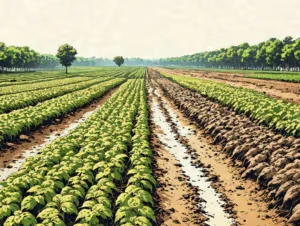The stark reality of climate change’s impact on food prices is no longer a future concern – it’s affecting our grocery bills and dinner tables right now. From the Mediterranean olive groves to American wheat fields, extreme weather events are reshaping our global food system and driving up costs in ways that disproportionately affect working families and vulnerable communities.
The Current Crisis
The numbers tell a devastating story of agricultural disruption. In 2023, Texas alone suffered over $4.8 billion in crop losses, with $2.3 billion in damages to cotton and $1.5 billion to forage and rangeland. Kansas faced similar devastation with $3.04 billion in losses, primarily affecting wheat, soybeans, and corn. These aren’t isolated incidents – they represent a pattern of escalating climate-related agricultural disasters.
The impact extends far beyond America’s heartland. The wettest 18 months on record in the UK devastated potato, wheat, and vegetable harvests, while severe droughts in Spain slashed olive production by 40%. When David Marchant’s River Berry Farm in Vermont lost 10 acres of crops to flooding in just 48 hours, it represented a $150,000 loss – a devastating blow to a small family farm.
The Science Behind the Crisis
The mechanisms of climate disruption are becoming clearer and more alarming. When temperatures rise, warmer air holds more moisture, leading to more intense precipitation events that can directly damage crops. Meanwhile, faster evaporation results in more severe droughts – creating a devastating cycle of flood and drought that leaves farmers struggling to adapt.
Rising temperatures are also changing the fundamental biology of our food system. Crop yields for maize are projected to decline by 24% by 2030 under high emission scenarios. While wheat might see some gains in certain regions, these benefits are offset by declining nutritional value – higher CO2 levels reduce the protein, zinc, and iron content in many staple crops.
The Cascading Effects
Climate change isn’t just affecting individual crops – it’s disrupting entire agricultural systems. In the Salinas Valley, changing weather patterns have created better environments for plant diseases and their insect carriers, leading to widespread crop failures. The 2023 lettuce crisis demonstrated how quickly these disruptions can affect consumer prices and availability.
The impact on livestock and fisheries adds another layer of complexity. Bangladesh’s innovative rice-fish production systems show how traditional agricultural methods must evolve to maintain food security while reducing emissions. These adaptations are crucial but require significant investment and community support.
The Economic Ripple Effect
The financial implications extend throughout the food system. Crop insurance payments for heat-related failures increased from $142.5 million in 2001 to $1.6 billion in 2022 – a thousand percent increase that ultimately affects consumer prices. Drought-related payments reached $7.6 billion in 2022, representing a 690% increase from 2001.
Regional Impacts and Inequalities
The burden of these changes falls heaviest on those least able to bear it. In lower-income countries, where farming costs make up over 70% of food prices, climate-related agricultural challenges create devastating ripple effects. The situation is particularly dire in regions already struggling with food security, such as sub-Saharan Africa and South Asia, where declining food production coincides with limited resources for adaptation.
Looking Forward: Solutions and Hope
Despite these challenges, innovative solutions are emerging. In Egypt, desert landscapes are being transformed into oases using biodynamic and organic agricultural methods. South African communities are developing perennial food forests that provide sustainable, nutrient-rich food while creating shade in urban environments. China is reducing dietary greenhouse gas emissions by promoting diverse, plant-based diets.
The transformation of our food systems could increase global food production by 9% by 2070, potentially reducing food prices by 16%. However, this requires immediate action and investment in climate-resilient agriculture, support for smallholder farmers, and policies that protect vulnerable consumers.
The time for action is now. We’re not just fighting to prevent future food insecurity – we’re already living in a world where climate change is reshaping our relationship with food. The choices we make today about how to adapt and transform our food systems will determine not just what we pay at the grocery store, but who has access to nutritious food in the years to come.
Sources:
[List of URLs from search results]
Citations:
[1] https://www.ifoodds.com/blog-the-impact-of-changing-weather-patterns-on-food-production-how-to-mitigate-its-effects/
[2] https://www.climatehubs.usda.gov/hubs/northwest/topic/economic-impact-climate-change-northwest-farms
[3] https://investigatemidwest.org/2023/11/02/as-extreme-weather-increasingly-threatens-crops-study-finds-taxpayers-pay-the-price/
[4] https://futureoffood.org/wp-content/uploads/2022/03/stories-of-action-from-14-countries.pdf
[5] https://www.heifer.org/blog/how-climate-change-affects-agriculture.html
[6] https://news.climate.columbia.edu/2018/07/25/climate-change-food-agriculture/
[7] https://climate.nasa.gov/news/3124/global-climate-change-impact-on-crops-expected-within-10-years-nasa-study-finds/
[8] https://www.fb.org/market-intel/major-disasters-and-severe-weather-caused-over-21-billion-in-crop-losses-in-2023
[9] https://foodsystemprimer.org/production/food-and-climate-change
[10] https://en.wikipedia.org/wiki/Effects_of_climate_change_on_agriculture
[11] https://www.preventionweb.net/news/nothings-predictable-extreme-weather-ruining-farmers-crops-and-their-finances
[12] https://pmc.ncbi.nlm.nih.gov/articles/PMC3556605/
[13] https://climatechange.chicago.gov/climate-impacts/climate-impacts-agriculture-and-food-supply
[14] https://climate.nasa.gov/news/3158/clusters-of-weather-extremes-will-increase-risks-to-corn-crops-society/











